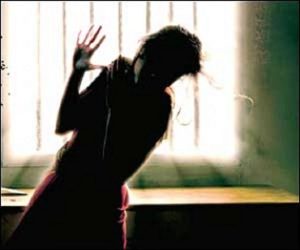Suroosh Irfani
A combination of hyper cruelty, public spectacle and the victim’s perceived innocence has always helped turn an obscure victim into a compelling icon of conscience. In this sense, there seems a striking parallel between the sexual violence against Mukhtar and the religious violence inflicted on the mystic martyr Hallaj some 1,100 years ago
For a country weary of its violence-ridden image, Mukhtar Mai seems the last person who could help Pakistan forge the new image it desperately seeks as a modern society. After all, Mukhtar is not just another gang rape victim in a society where silence, suicide or banishment are the only options for such victims. She is the survivor of a “theatre of cruelty” that defies the wildest hardcore fantasies: not only was her gang-rape sanctioned by the local village council as “punishment” for a crime she never committed, the rape was turned into a public spectacle for the entire village – even as her teenaged brother was sodomised for having an alleged affair with a 30 year woman of a rival tribe.
Even so, Mukhtar has come a long way since her harrowing ordeals in southern Punjab’s Meerwalla village some three years ago. The support of her family and local women’s group, and compensation money from the government have helped this 29 year old illiterate woman of yore to morph into a fighter for dignity and justice. Indeed, Mukhtar Mai (meaning, ‘free woman’) is probably the first rape victim in the Muslim world who has turned her personal trauma into a universal “mission against outdated and un-Islamic customs and traditions”, as she declared at a local rally marking the International Woman’s Day earlier this month.
The educational project that she launched with her compensation money by starting a school in her village is already expanding, thanks to the growing support from multiple sources. An article by Nicholas Kristof in The New York Times last year highlighting Mukhtar’s “passionate belief in the redemptive power of education” raked in donations of $133,000 while Canadian High Commissioner Margaret Huber travelled all the way to Meerwalla to present Mukhtar with a Rs 2.1 million cheque.
Inevitably, however, Mukhtar’s detractors include many educated Pakistanis who believe she has ganged up with women’s groups to cash in on the ‘scandal’ and besmirch Pakistan’s image. A case in point is the press conference of Malik Saleem, the counsel for Mukhtar’s five alleged rapists who were sentenced to death in August 2003 by an Anti-Terrorism Court, only to be acquitted by an appeals court that overturned the verdict. As reported in Dawn (March 9, 2005), the defence counsel complained that the Meerwalla case was “blown out of proportion” and got “undue attention of national and international media” – even though it was just one among many such cases in the country. “Not a single case got as much projection as Mukhtar Mai’s”, he reportedly said, even though “540 women were molested or raped, 24 burnt by acid, 634 abducted and 115 killed on one pretext or the other in southern Punjab”.
Whatever the merits of such arguments, a combination of hyper cruelty, public spectacle and the victim’s perceived innocence has always helped turn an obscure victim into a compelling icon of conscience. In this sense, there seems a striking parallel of sorts between the sexual violence enacted in Meerwalla against Mukhtar on June 22, 2003, and the religious violence inflicted in Baghdad on the mystic martyr Hallaj some 1,100 years ago.
The “theatre of cruelty” that in 922 silenced Hallaj’s ecstatic intonation – that he was the creative Truth (an’al Haq) – was excessive by any standards. His lacerated body, virtually torn by 500 relentless lashes, was hooked on a cross after his hands and feet were amputated. He was still alive the following day when he was beheaded. Then his body was burnt and the ashes sprinkled on the river – legend has it that the ashes formed the word Allah as a chilling indictment of the judges who had sentenced him: Hallaj had become a folk hero even before his blood was washed away from the public square. The 13th century poet Rumi invoked him as a symbol of truth against falsehood. He became an emancipatory force in a spiritual politics overweighed by orthodoxies.
Indeed, there seems no dearth of Muslim poets and reformers who invoked Hallaj as an icon of defiance against the stifling hold of conservative clerics. Even Iqbal, Pakistan’s spiritual father, found a kindred soul in Hallaj and gained fresh insights about him on meeting Hallaj’s French biographer, Louis Massignon, in Lahore – so much so that in some of his iconoclastic flights, Iqbal attributes his own transgressions to the blood of Hallaj now running through his veins.
While Mukhtar Mai is no Hallaj, like Hallaj she is a folk hero whose ordeals have turned her into a witness of truth and justice. Moreover, as with Hallaj whom many regard as a spiritual bridge between different cultures, Mukhtar Mai is an inspiring symbol with global reach and linkages cutting across culture and class.
Even so, Mukhtar Mai’s modernity does not so much lie in her classless appeal as in the transformation of her subjectivity from a passive victim of the past into a dynamic icon of the present. Her journey from a voiceless woman from the backwaters of Pakistan to a crusader in a global fight for education and awareness makes her an apt symbol of Pakistan’s modernity – a project that goes back to Sir Syed Ahmed Khan’s reformist educational movement in the 19th century for infusing new thinking among Muslims, and of which Mukhtar Mai seems a surprising successor.
This being so, Pakistan will do well to promote Mukhtar Mai as the true face of Pakistani modernity. For starters, a documentary about Mukhtar Mai should be made part of Pakistan Studies courses; and shown in all schools, colleges and madrassas of the country.
Source: Daily Times
Date:3/25/2005


